Where the Jobs Are and Aren’t in the New U.S. Economy
It may be too soon to declare robots are replacing human workers. Machines aren’t to blame for everything: Some jobs on the decline in the U.S., whether due to automation technology or not, are beginning to disappear based on changing industry and consumer behaviors and needs.
Chemical plant operators and locomotive workers, for instance, are among the top declining jobs as chemical plants and train systems turn to alternative goods and services.
Postal service, insurance and retail workers are also seeing fewer jobs created, according to the Bureau of Labor Statistics. Many of these jobs made between $40,000 and $75,000 in median pay in 2016 and required at least a high school or bachelor’s level of education.
It’s no surprise where the economy is headed, with tech jobs, software and artificial intelligence on the rise. Many of the fastest growing jobs are tech or medical related.
So, first the bad news — we start with the top dozen jobs on the decline in the U.S., but then we’ll end on an optimistic note — with the dozen jobs on the rise.
On the Decline: Insurance Underwriters
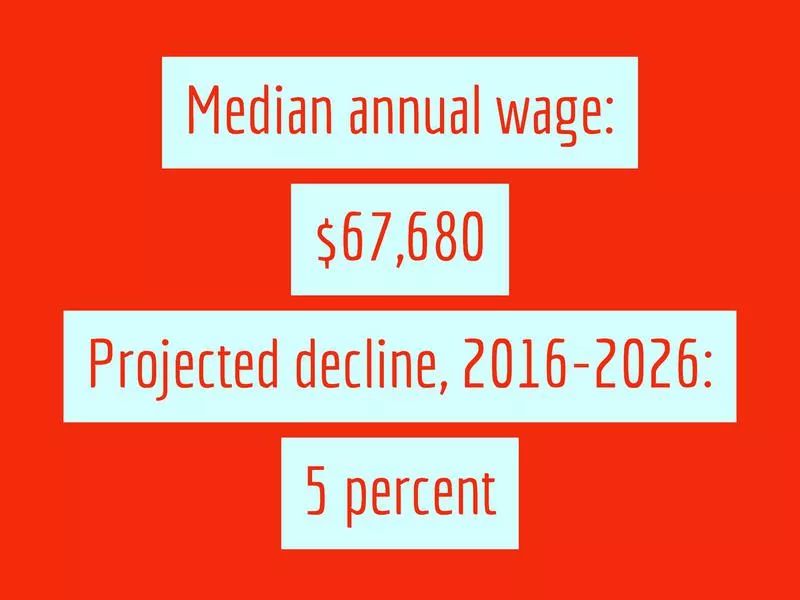
Insurance underwriters determine whether to provide insurance and set those terms.
They look at insurance applications and decide the coverage amounts and premiums, but automated underwriting software is starting to make the process faster and lower the demand for as many human underwriters.
These workers made an annual median wage of $67,680 in 2016, and employment is expected to decline 5 percent from 2016 to 2026, according to the BLS.
On the Decline: Labor Relations Specialists
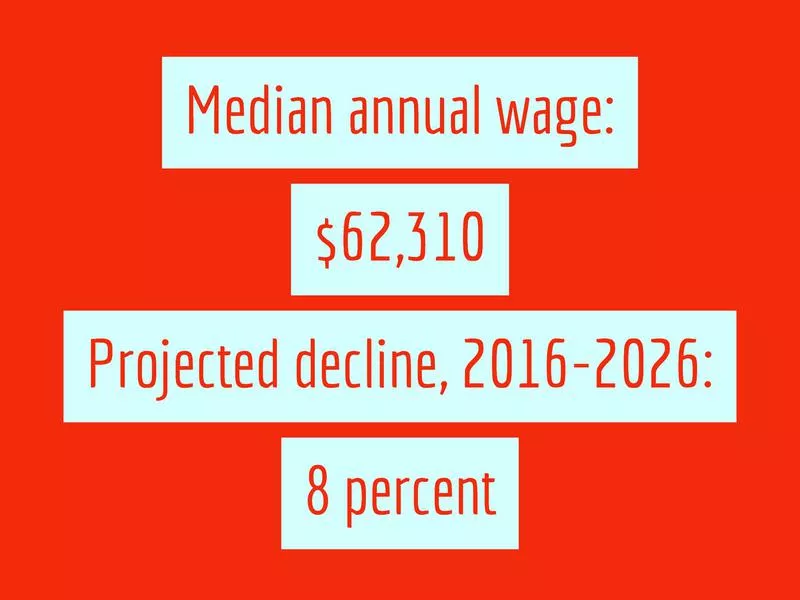
Labor relations specialists will see an 8 percent decline through 2026.
These human resources workers administer labor contracts, which can range from wages to union issues.
The Bureau of Labor Statistics expects employment to drop as union membership declines.
The median annual wage for labor relations specialists was $62,310 in May 2016.
On the Decline: Chemical Plant and System Operators
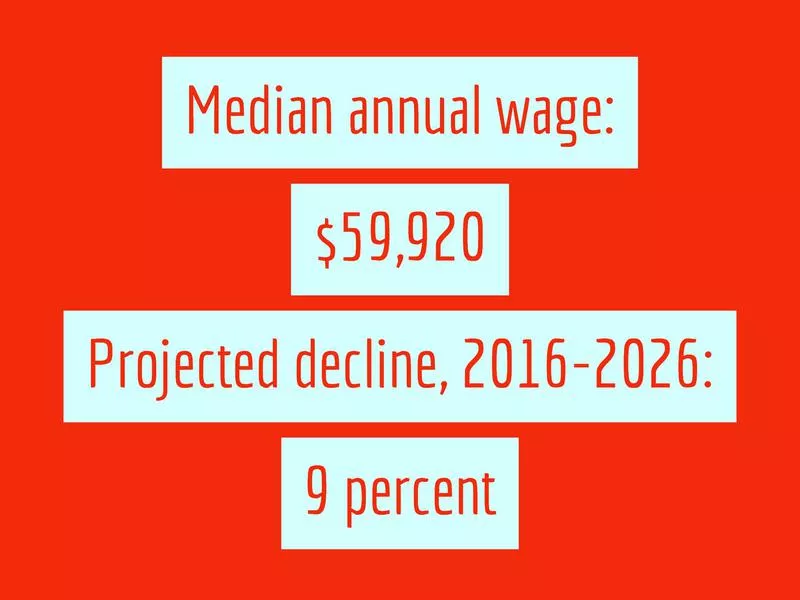
Employment for operators is expected to drop 9 percent through 2026.
In 2016, there were 33,200 chemical plant and systems operators jobs which paid an annual median wage of $59,920.
While these workers handle everything from operating chemical processes to the machine systems at a plant, many chemical companies are becoming more environment-friendly and expanding in other manufacturing areas.
On the Decline: Postal Service Mail Carriers
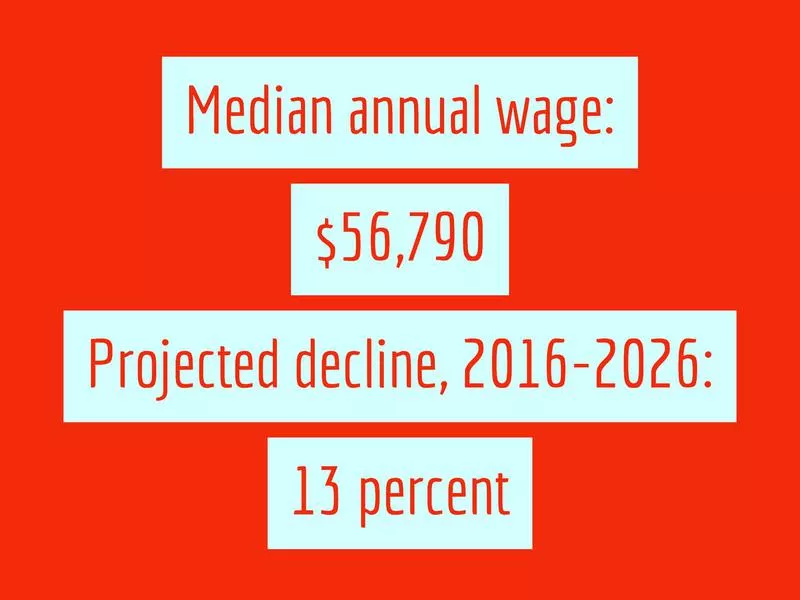
Postal service jobs, from delivery to sorters, are all on the downturn. Overall employment for postal service workers is projected to drop 13 percent through 2026, according to the BLS.
Like many sectors, postal service work is turning to automated sorting systems as budgets tighten.
The median annual wage for postal service workers was $56,790 in May 2016.
There will be some job openings as older workers retire, but these jobs are typically very competitive.
On the Decline: Railroad Workers
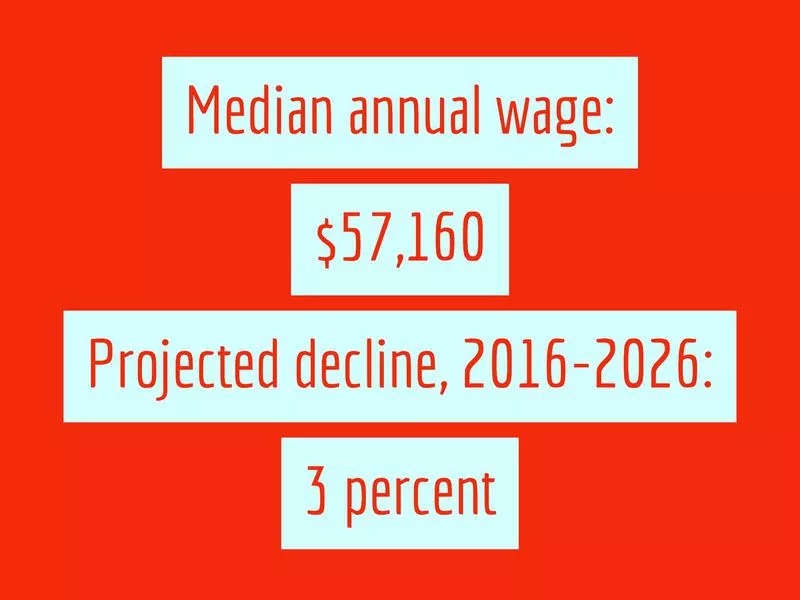
Locomotive engineers make sure passenger and freight trains run on time and safely. Some are in charge of operating trains, while others operate signals and switches from the rail yard.
The transportation industry is gearing up for self-driving cars and on-demand rides, and freight train systems are looking to decrease the transportation of bulk commodities, like coal and oil.
Nearly all locomotive engineers; conductors and yardmasters; and brake, signal, and switch operators work in the rail transportation industry. Rail yard engineers work in rail transportation and also support activities for rail. The median annual wage for railroad workers was $57,160 in May 2016.
Additionally, the turn to natural gas instead of coal for electricity means railroads will be looking to reduce employment to keep up with changing demands.
The BLS predicts employment will drop 3 percent over the decade.
On the Decline: Secretaries and Executive Administrative Assistants
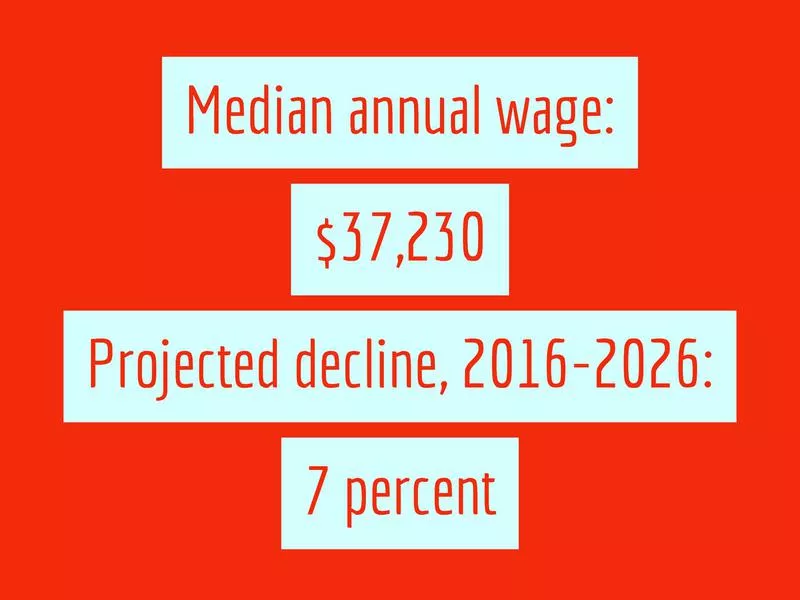
Will voice assistants and apps take over these clerical and administrative duties for human assistants?
In 2016, most secretaries and assistants worked in schools, hospitals, government and medical offices full-time and made an annual median wage of $37,230.
Employment in those secretaries will reduce 7 percent by 2026, said the BLS.
On the Decline: Machinists, Tool and Die Makers
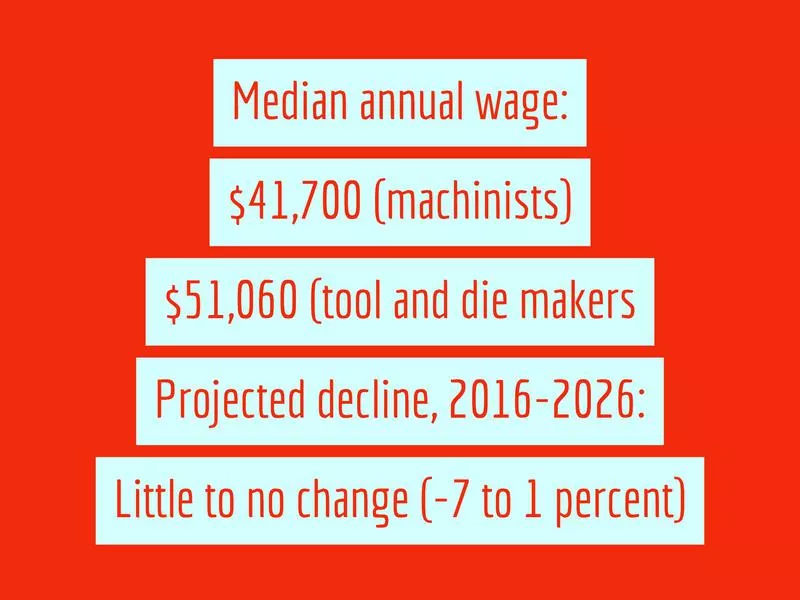
These metal makers work in factories and machine shops producing precision parts, instruments and tools.
The median annual wage for machinists was $41,700 in May 2016, and for tool and die makers it was $51,060.
The BLS says employment will likely show little or no growth in the next eight years.
Overall employment will go down 7 percent by 2026, but improvements in technologies might actually increase job prospects for machinists needed to set up and man the systems.
On the Decline: Adult Literacy Teachers
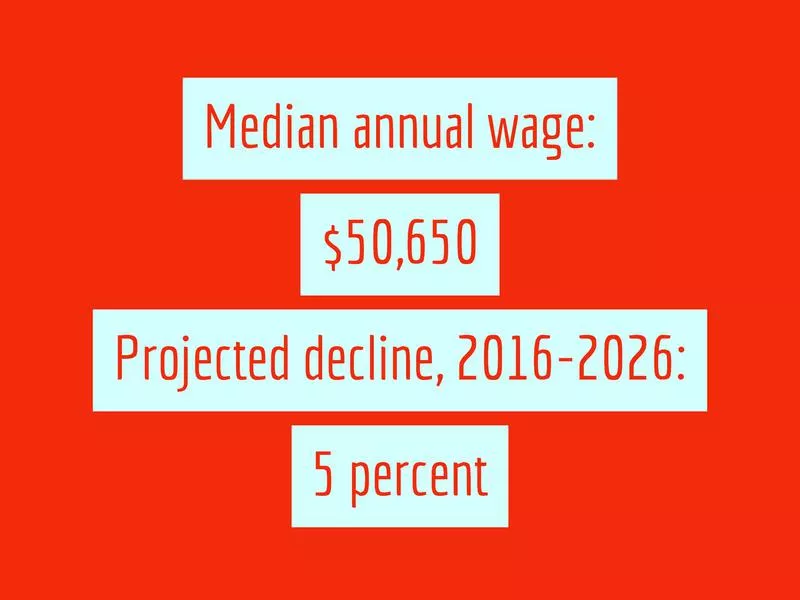
Work in adult literacy and high school equivalency diploma teachers focusing in basic reading and writing skills has declined as enrollment dropped in adult education and English as a Second Language programs.
At the same time, high school graduation rates have climbed, reducing the need for students to get a high school equivalent diploma.
The median annual wage for adult literacy and high school equivalency diploma teachers was $50,650 in May 2016.
Funding changes for these adult learning programs may impact the employment growth, as well, with the BLS estimating a 5 percent dip in employment by 2026.
On the Decline: Advertising Sales Agents
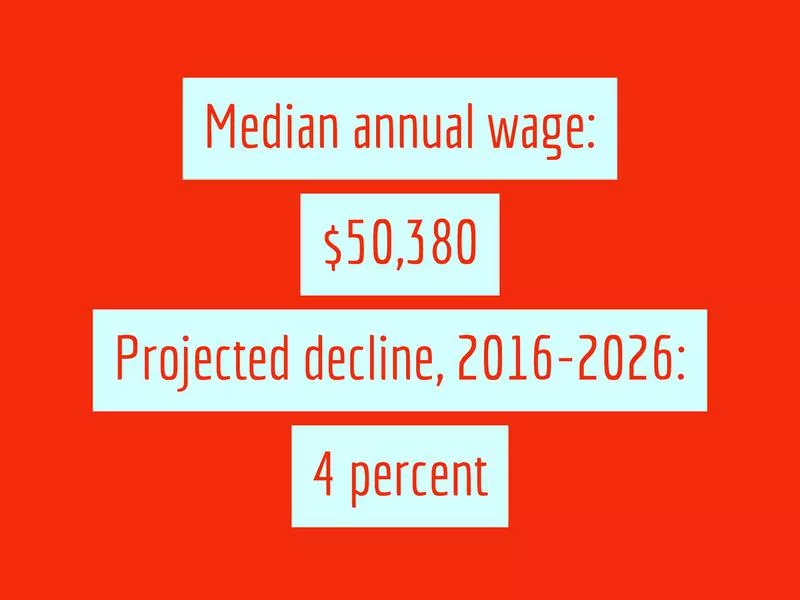
Ad sales agents made an annual median wage of $50,380, or about $24.22 per hour, in 2016 selling advertising to businesses and individuals.
While the government projects employment to go down 4 percent by 2026, there may be some growth for sales agents focusing on Internet companies.
However, the majority of media companies that still rely on advertising revenue will decrease in employment of sales agents, especially newspaper publishers.
Publishers are continuing to shift to digital ads and websites in order to offset these losses.
On the Decline: Water and Wastewater Treatment Operators
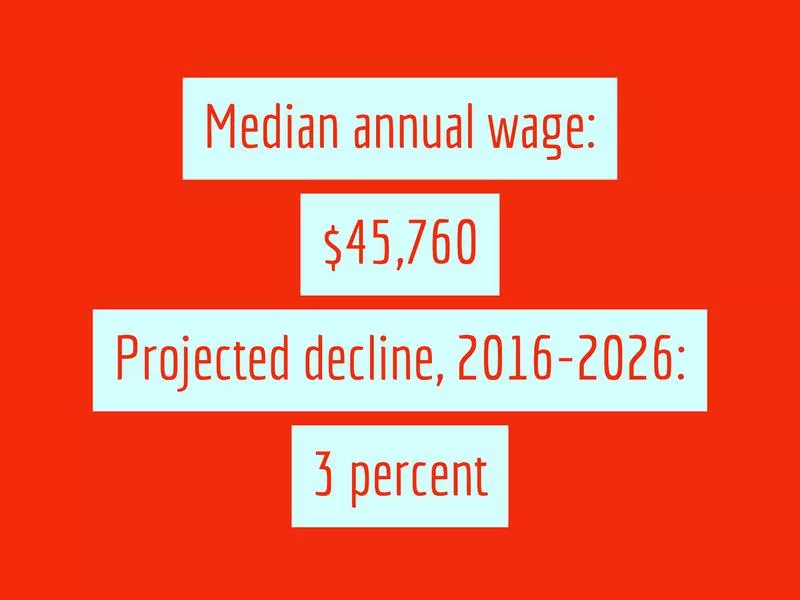
Operators working at water and wastewater plants will see a 3 percent drop, or 3,800 jobs, in employment by 2026.
The median annual wage for water and wastewater treatment plant and system operators was $45,760 in May 2016.
These operators use control boards and machines to transfer and treat wastewater, but automation is again the culprit here.
More plants are shifting to automated systems to manage the treatment process, but the technology will not entirely wipe out the human workers. Some plants will still need the human operators to navigate the more complex controls.
On the Decline: Correctional Officers and Bailiffs
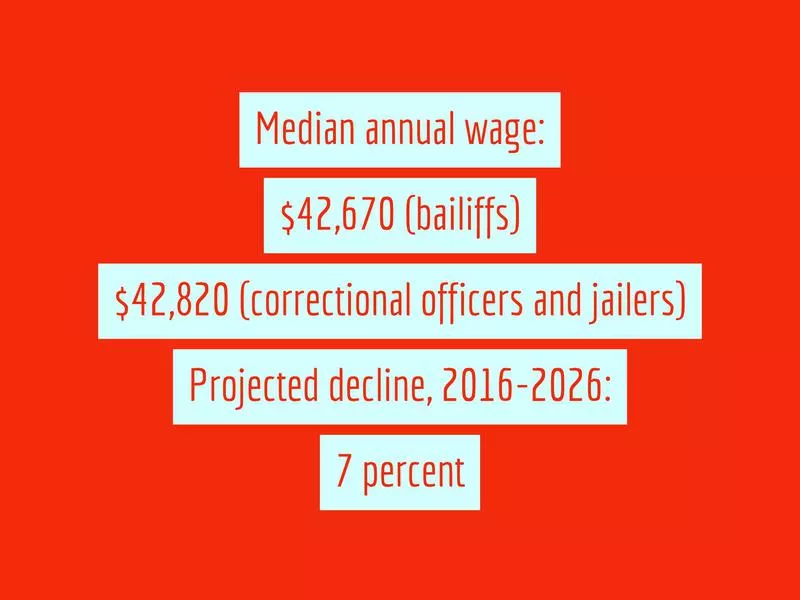
Correctional organizations will see a 7 percent drop in employment by 2026. In 2016, there were 468,600 correctional officer and bailiff jobs.
The BLS predicts fewer workers in corrections will be needed as state and local governments reduce their prison budgets.
The median annual wage for bailiffs was $42,670 in May 2016, for correctional officers and jailers it was $42,820.
Because incarceration costs have become so high, many states are aiming to pass laws requiring shorter prison terms and alternatives to imprisonment.
Jobs for law enforcement officers, on the other hand, are slowly growing.
On the Decline: Desktop Publishers
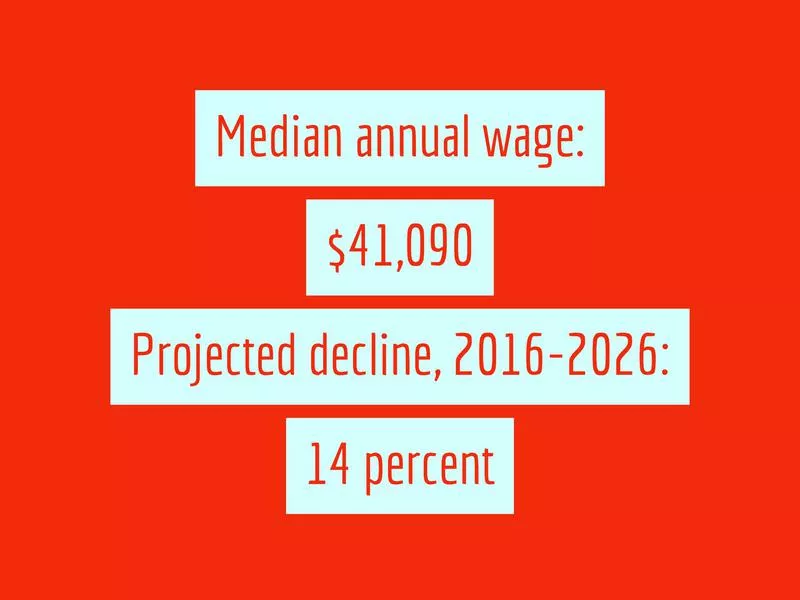
Designers for newspapers, advertisements and books online and in print are seeing a slowdown in employment.
The median annual wage for desktop publishers in May 2016 was $41,090.
By 2026, employment for these workers will dip 14 percent as companies hire graphic designers and web designers instead.
Fewer organizations are publishing their materials and content in print, so employment will keep falling as digital takes over.
On the Decline: Assemblers and Fabricators
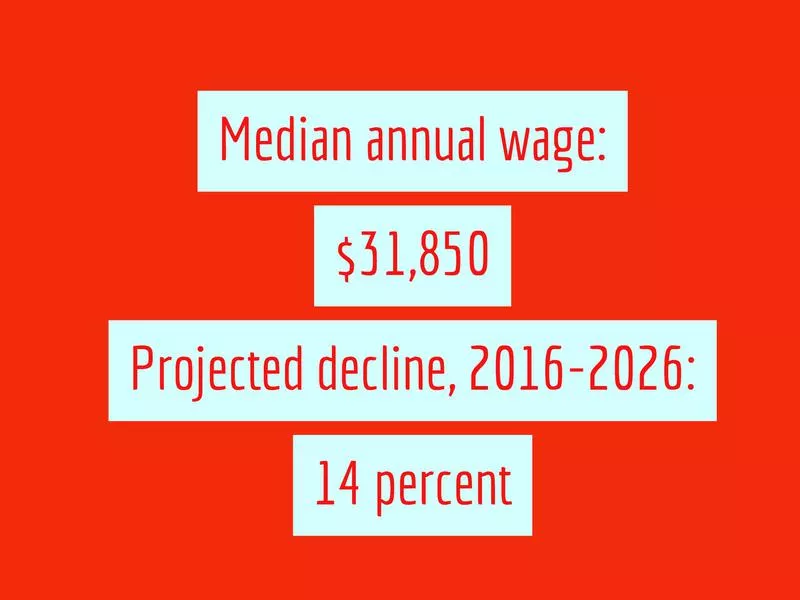
Assemblers and fabricators make the parts and put together tools, machines, engines, computers, aircraft, ships, boats, toys, electronic devices, control panels, and more. They made an annual median wage of $31,850 in 2017.
The job sector faces a projected decline of 14 percent over the decade.
The education level and qualifications for these jobs varies, but a high school diploma is enough for most jobs. Experience and additional training are needed for more advanced assembly work.
Increased productivity due to advances in automation and collaborative robotics is expected to reduce demand for assemblers and fabricators.
On the Decline: Bill and Account Collectors
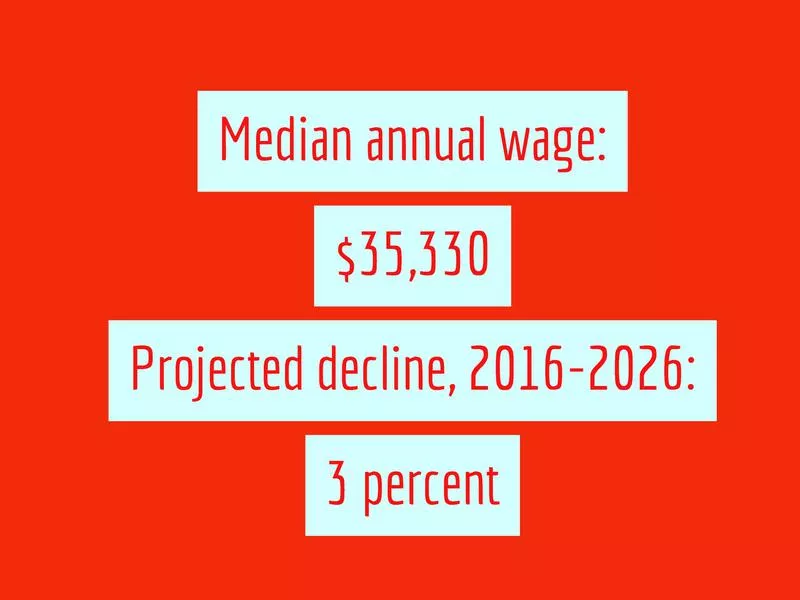
Bill and account collectors recover payment on overdue bills and negotiate repayment plans with debtors. Many collectors work in a call center for a third-party collection agency rather than the original creditor.
The median annual wage for bill and account collectors was $35,330 in 2017.
Collectors usually must have a high school diploma., with a few months of on-the-job training.
Employment is projected to decline 3 percent from 2016 to 2026 due to automation.
On the Decline: Buyers and Purchasing Agents
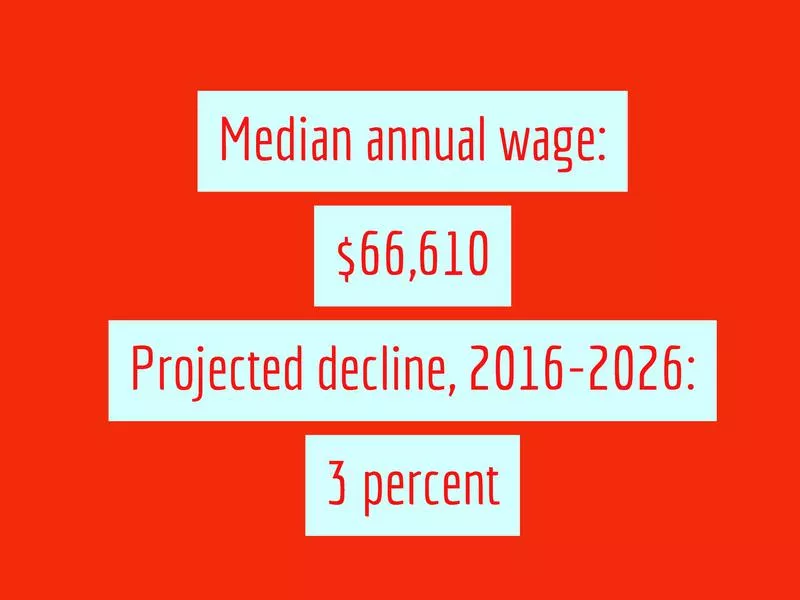
Buyers and purchasing agents buy products and services for organizations to use or resell.
The median annual wage for purchasing managers, buyers, and purchasing agents was $66,610 in 2017.
Buyers and purchasing agents typically have a bachelor’s degree. Purchasing managers must also have a few years of work experience.
Employment of purchasing managers, buyers and purchasing agents is projected to decline 3 percent from 2016 to 2026, mostly due to outsourcing and automation.
On the Decline: Secretaries and Administrative Assistants
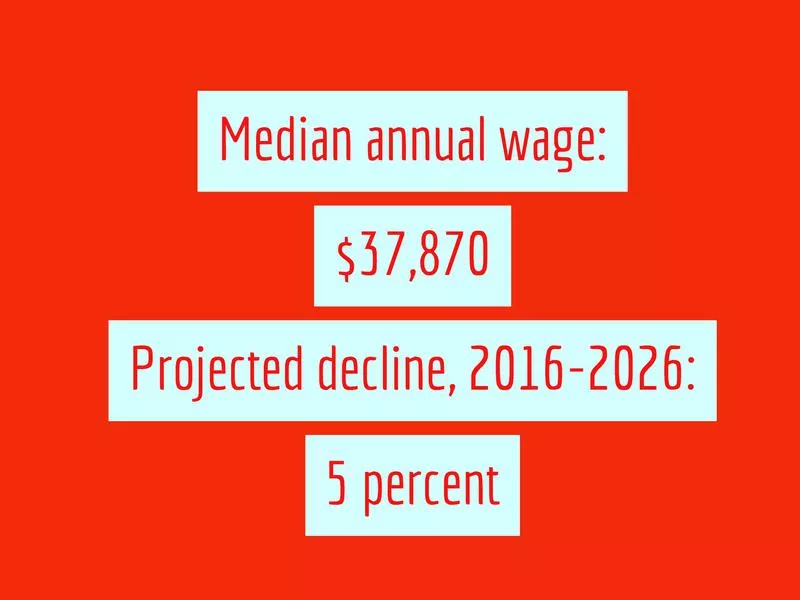
Secretaries and administrative assistants perform routine clerical and administrative duties, organizing files, preparing documents, scheduling appointments, and supporting other staff.
The median annual wage for secretaries and administrative assistants was $37,870 in 2017.
High school graduates who have experience using computer software applications usually qualify for entry-level positions.
Employment of secretaries and administrative assistants is projected to decline 5 percent from 2016 to 2026.
On the Decline: Quality Control Inspectors
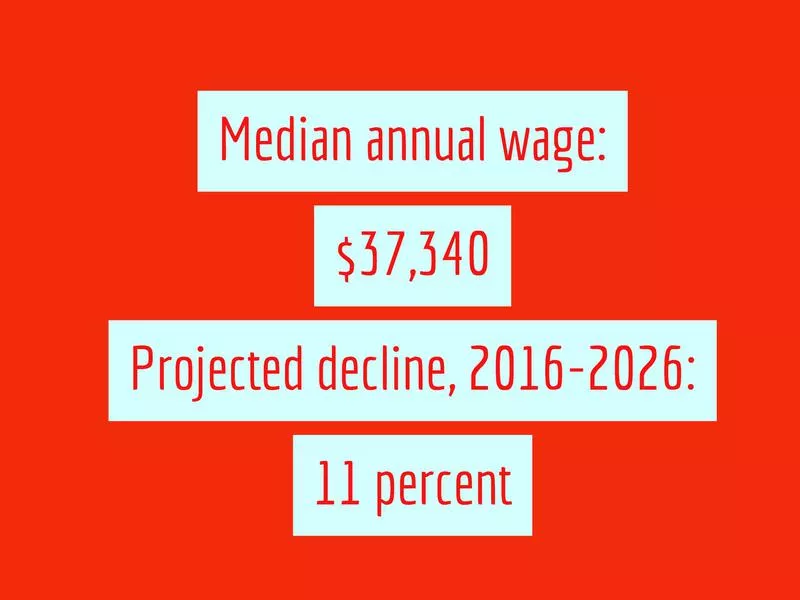
Quality control inspectors examine products and materials for defects or deviations from specifications.
The median annual wage for quality control inspectors was $37,340 in 2017.
Most quality control inspectors need a high school diploma and receive on-the-job training.
Employment of quality control inspectors is projected to decline 11 percent from 2016 to 2026. Improvements in technology are expected to automate inspection tasks.
On the Decline: Insurance Underwriters
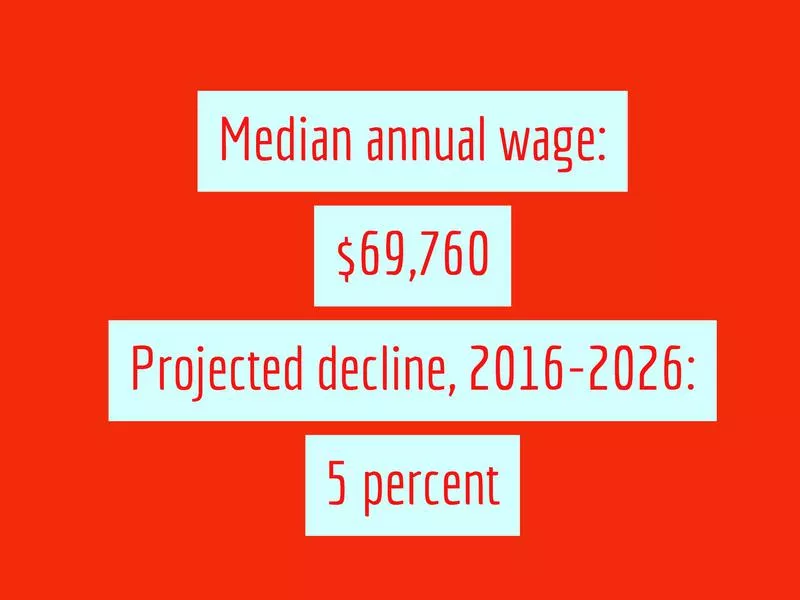
Insurance underwriters decide whether to provide insurance, evaluate insurance applications and determine coverage amounts and premiums.
The median annual wage for insurance underwriters was $69,760 in 2017.
Employers prefer to hire candidates who have a bachelor’s degree. Certification is generally necessary for advancement to senior underwriter and underwriter manager positions.
Employment is projected to decline 5 percent from 2016 to 2026 due to automated underwriting software, reducing the need for as many underwriters.
On the Decline: Jewelers and Metal Workers
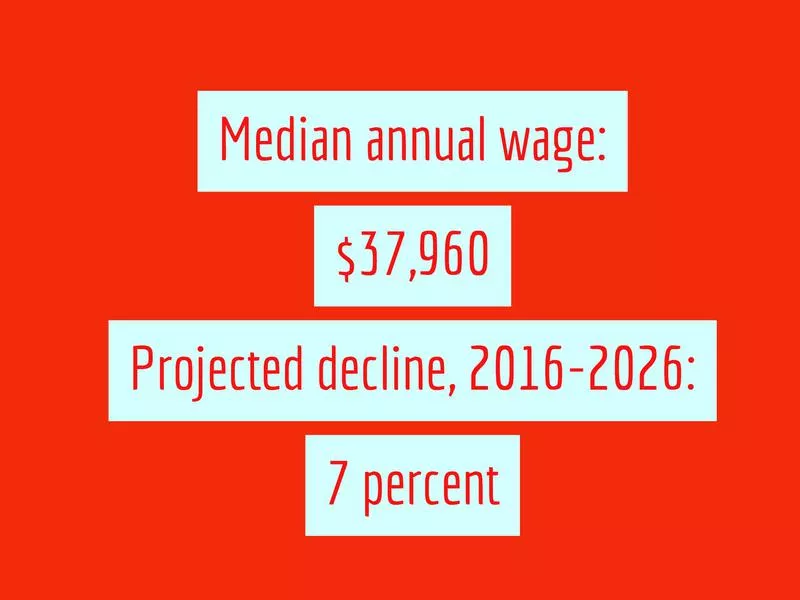
Jewelers and metal workers design, construct, adjust, repair, appraise and sell jewelry.
The median annual wage for jewelers and precious stone and metal workers was $37,960 in 2017.
These workers typically need a high school diploma to enter the occupation, and they learn the skills of the trade through on-the-job training.
Employment is projected to decline 7 percent from 2016 to 2026.
Now the Good News: Where the Jobs Are Going?

The panels from Tampa Electric Company’s Big Bend Solar Station in Gibsonton, Fla power about 3,000 homes in the area. Solar panel installation is expected to be the faster growing job in the U.S. economy over the next decade. Chris O’Meara / AP Photo
According to the Bureau’s employment projections for the next 10 years, the top ten fastest-growing occupations include solar photovoltaic installers, wind turbine service technicians, home health aides and software developers.
Many companies and workers in these fields are hopeful technological advances will pull older industries ahead, especially in cases of the health care and energy sectors.
The Bureau expects employment to pick up in the next decade as the labor force gets older and diversifies. This growth projection also takes into account the distribution of the labor force, which in 2026 will be made up of 24.8 percent of people age 55 and older.
As the workforce continues getting older — and the size of that group gets bigger — many will head into retirement and require more health care services.
Here are the top dozen jobs on the rise in the U.S:
On the Rise: Solar Photovoltaic Installers
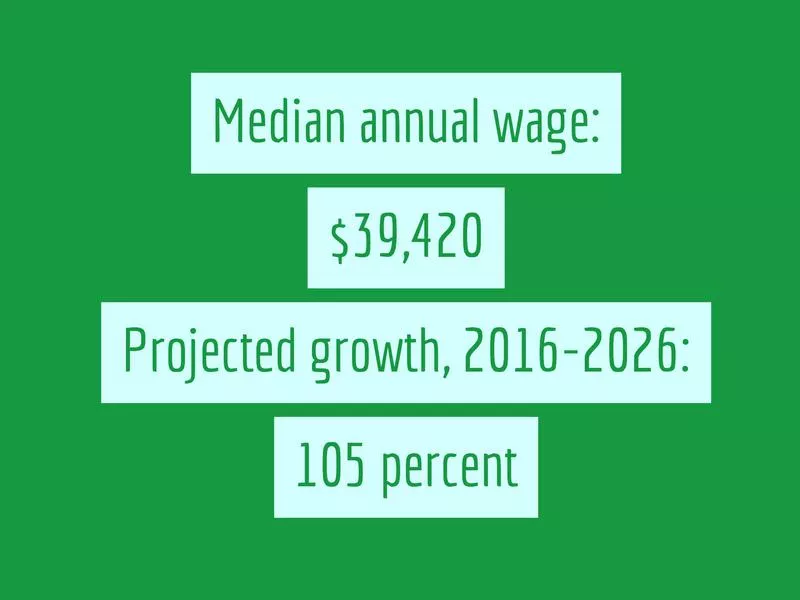
Solar photovoltaic (PV) installers, also known as PV installers, assemble, install, and maintain solar panel systems on rooftops or other structures are .
According to the BLS, most installers need a high school diploma and typically receive on-the-job training lasting up to a year, but some candidates take courses at a technical school or community college.
The median annual wage for solar photovoltaic installers was $39,240 in May 2016.
Employment of solar photovoltaic (PV) installers is projected to grow 105 percent from 2016 to 2026, much faster than the average for all occupations.
The continued expansion and adoption of solar panel installations will result in excellent job opportunities for qualified individuals, particularly those who complete photovoltaic training courses at a community college or technical school.
On the Rise: Wind Turbine Service Technicians
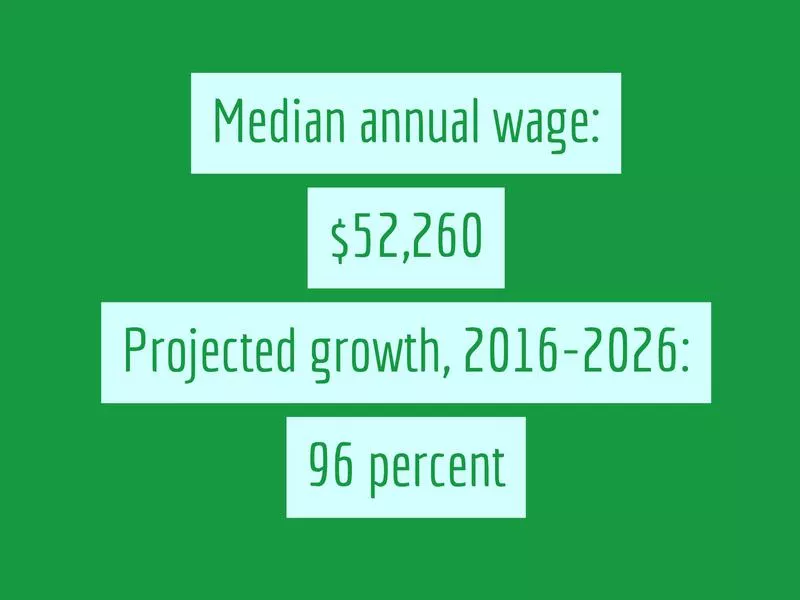
Wind turbine service technicians, also known as windtechs, install, maintain, and repair wind turbines.
According to the BLS, wind turbine service technicians generally work outdoors, in confined spaces, and often at great heights. Although the majority of windtechs work full time, they may also be on call to handle emergencies during evenings and weekends.
Most wind turbine service technicians learn their trade by attending a technical school. They also receive on-the-job training.
The median annual wage for wind turbine technicians was $52,260 in May 2016.
Employment of wind turbine service technicians is projected to grow 96 percent from 2016 to 2026, much faster than the average for all occupations.
Because wind electricity generation is expected to grow rapidly over the coming decade, additional technicians will be needed to install and maintain new turbines. Job prospects are expected to be excellent.
On the Rise: Home Health Aides
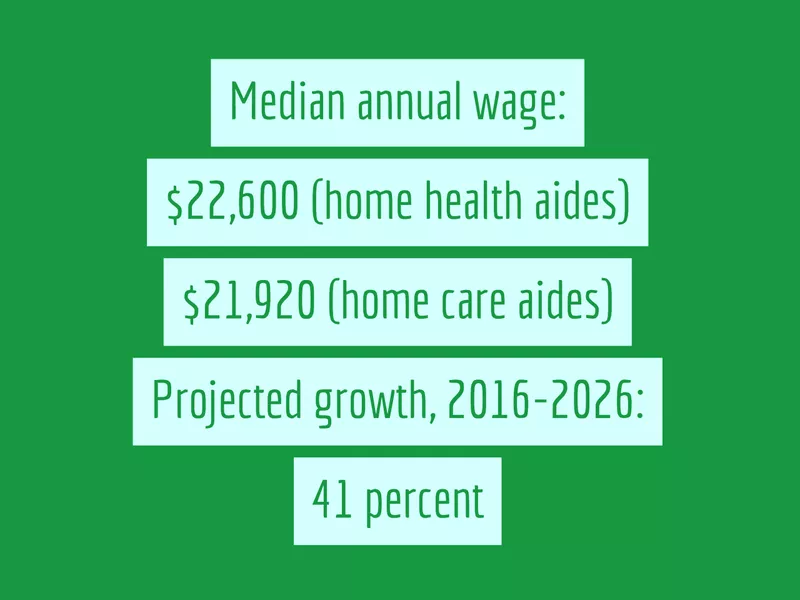
Home health aides and personal care aides help people with disabilities, chronic illnesses, or cognitive impairment by assisting in their daily living activities. They often help older adults who need assistance. In some states, home health aides may be able to give a client medication or check the client’s vital signs under the direction of a nurse or other healthcare practitioner.
Home health aides and personal care aides work in a variety of settings, including clients’ homes, group homes, and day services programs.
Home health aides and personal care aides typically need a high school diploma or equivalent, though some positions do not require it. Those working in certified home health or hospice agencies must complete formal training and pass a standardized test.
The median annual wage for home health aides was $22,600, and $21,920 for personal care aides, in May 2016.
Employment of home health aides and personal care aides is projected to grow 41 percent from 2016 to 2026, much faster than the average for all occupations.
As the baby-boom population ages and the elderly population grows, the demand for the services of home health aides and personal care aides will continue to increase.
On the Rise: Mathematicians and Statisticians
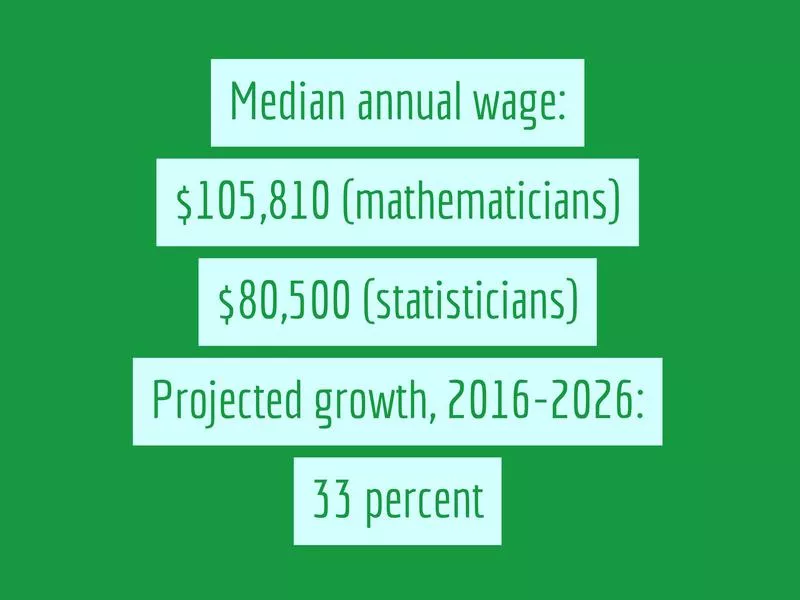
Mathematicians and statisticians analyze data and apply mathematical and statistical techniques to help solve real-world problems in business, engineering, healthcare, or other fields.
Many mathematicians and statisticians work in the federal government and in private science and engineering research companies. They may work on teams with engineers, scientists, and other professionals.
Mathematicians and statisticians typically need at least a master’s degree in mathematics or statistics. However, some positions are available to those with a bachelor’s degree.
The median annual wage for mathematicians was $105,810 in May 2016.
The median annual wage for statisticians was $80,500 in May 2016.
Overall employment of mathematicians and statisticians is projected to grow 33 percent from 2016 to 2026, much faster than the average for all occupations. Businesses will need these workers to analyze the increasing volume of digital and electronic data.
On the Rise: Nurse Practitioners
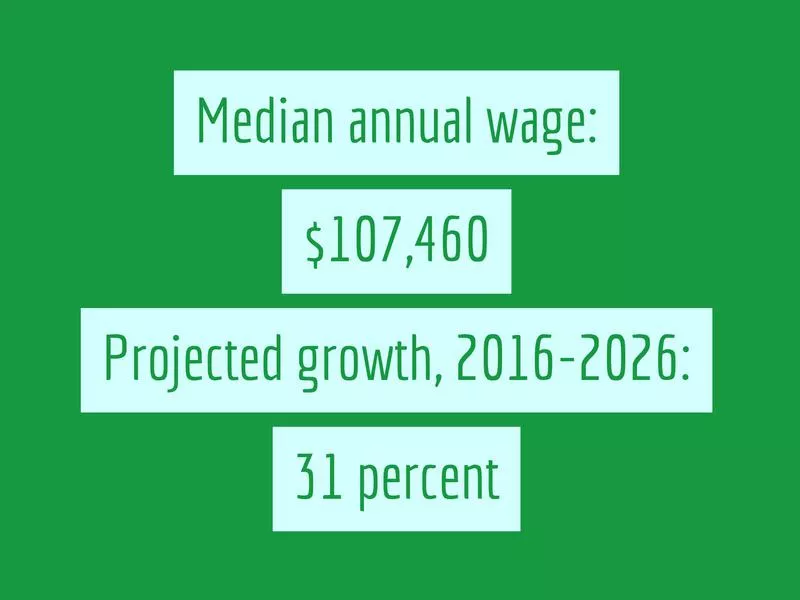
Nurse anesthetists, nurse midwives, and nurse practitioners, also referred to as advanced practice registered nurses (APRNs), coordinate patient care and may provide primary and specialty healthcare. The scope of practice varies from state to state.
Nurse anesthetists, nurse midwives, and nurse practitioners work in a wide variety of healthcare settings, including hospitals, physicians’ offices, and clinics. Most APRNs work full time.
Nurse anesthetists, nurse midwives, and nurse practitioners must earn at least a master’s degree in one of the APRN roles. They must also be licensed in their state and pass a national certification exam.
The median annual wage for nurse anesthetists, nurse midwives, and nurse practitioners was $107,460 in May 2016.
Overall employment of nurse anesthetists, nurse midwives, and nurse practitioners is projected to grow 31 percent from 2016 to 2026, much faster than the average for all occupations. Growth will occur primarily because of an increased emphasis on preventive care and demand for healthcare services from an aging population.
On the Rise: Physical Therapist Assistants
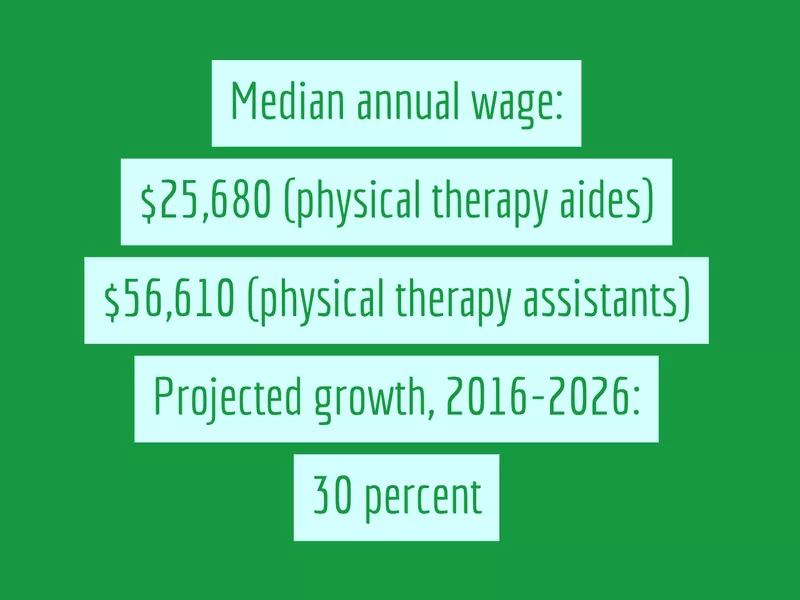
Physical therapist assistants, sometimes called PTAs, and physical therapist aides work under the direction and supervision of physical therapists. They help patients who are recovering from injuries and illnesses regain movement and manage pain.
Most physical therapist assistants and aides work in physical therapists’ offices or in hospitals. Physical therapist assistants and aides are frequently on their feet and moving as they set up equipment and help care for patients.
Physical therapist assistants entering the profession need an associate’s degree from an accredited program. All states require physical therapist assistants to be licensed or certified. Physical therapist aides usually have a high school diploma and receive on-the-job training.
The median annual wage for physical therapist aides was $25,680 in May 2016.
The median annual wage for physical therapist assistants was $56,610 in May 2016.
Overall employment of physical therapist assistants and aides is projected to grow 30 percent from 2016 to 2026, much faster than the average for all occupations. Demand for physical therapy is expected to increase in response to the healthcare needs of an older population and individuals with chronic conditions, such as diabetes and obesity.
On the Rise: Medical Assistants
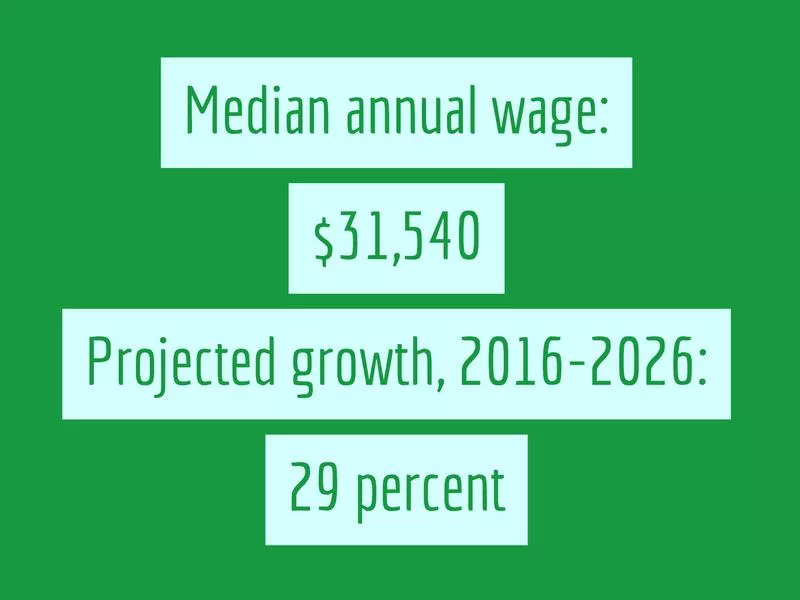
Medical assistants complete administrative and clinical tasks in the offices of physicians, hospitals, and other healthcare facilities. Their duties vary with the location, specialty, and size of the practice.
Most medical assistants work in physicians’ offices, hospitals, outpatient clinics, and other healthcare facilities.
Most medical assistants have postsecondary education such as a certificate. Others enter the occupation with a high school diploma and learn through on-the-job training.
The median annual wage for medical assistants was $31,540 in May 2016.
Employment of medical assistants is projected to grow 29 percent from 2016 to 2026, much faster than the average for all occupations.
The growth of the aging baby-boom population will continue to increase demand for preventive medical services, which are often provided by physicians.
As a result, physicians will hire more assistants to perform routine administrative and clinical duties, allowing the physicians to see more patients.
On the Rise: Genetic Counselors

Genetic counselors assess individual or family risk for a variety of inherited conditions, such as genetic disorders and birth defects. They provide information and support to other healthcare providers, or to individuals and families concerned with the risk of inherited conditions.
Genetic counselors work in university medical centers, private and public hospitals, diagnostic laboratories, and physicians’ offices. They work with families, patients, and other medical professionals. Most genetic counselors work full time.
Genetic counselors typically need a master’s degree in genetic counseling or genetics, and board certification.
The median annual wage for genetic counselors was $74,120 in May 2016.
Employment of genetic counselors is projected to grow 29 percent from 2016 to 2026, much faster than the average for all occupations. Ongoing technological innovations, including improvements in lab tests and developments in genomics, which is the study of the whole genome, are giving counselors opportunities to conduct more types of analyses.
On the Rise: Occupational Therapy Assistants
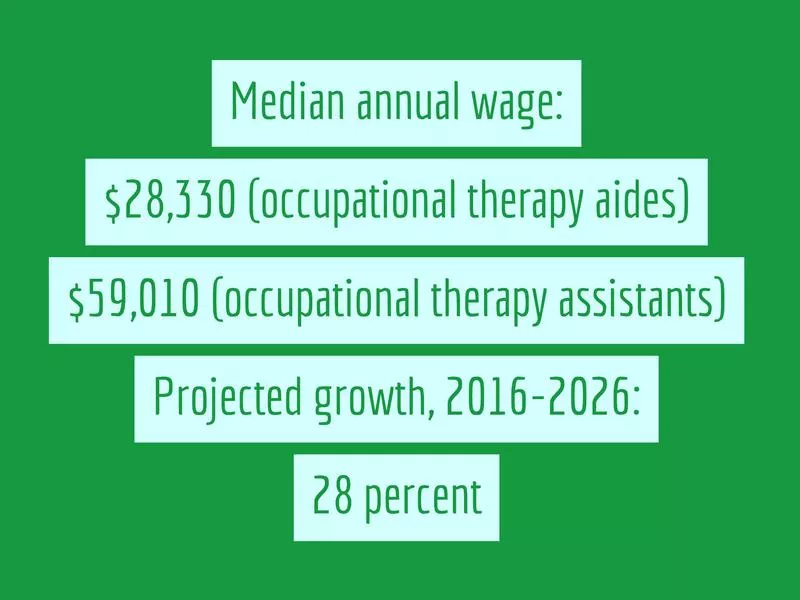
Occupational therapy assistants and aides help patients develop, recover, improve, as well as maintain the skills needed for daily living and working. Occupational therapy assistants are directly involved in providing therapy to patients; occupational therapy aides typically perform support activities. Both assistants and aides work under the direction of occupational therapists.
Occupational therapy assistants and aides work primarily in occupational therapists’ offices, in hospitals, and in nursing care facilities. Occupational therapy assistants and aides spend much of their time on their feet while setting up equipment and, in the case of assistants, providing therapy to patients.
Occupational therapy assistants need an associate’s degree from an accredited occupational therapy assistant program. All states regulate the practice of occupational therapy assistants. Occupational therapy aides typically need a high school diploma or equivalent and receive training on the job.
The median annual wage for occupational therapy aides was $28,330 in May 2016.
The median annual wage for occupational therapy assistants was $59,010 in May 2016.
Overall employment of occupational therapy assistants and aides is projected to grow 28 percent from 2016 to 2026, much faster than the average for all occupations.
Occupational therapy will continue to be an important part of treatment for people with various illnesses and disabilities.
On the Rise: Software Developers
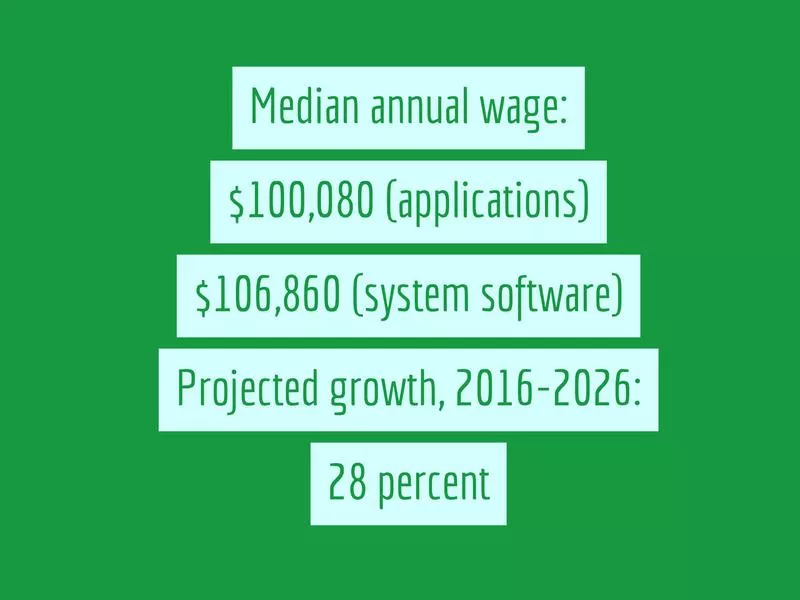
Software developers are the creative minds behind computer programs. Some develop the applications that allow people to do specific tasks on a computer or another device. Others develop the underlying systems that run the devices or that control networks.
Many software developers work for firms that deal in computer systems design and related services, manufacturing, or for software publishers.
Software developers usually have a bachelor’s degree in computer science and strong computer programming skills.
The median annual wage for software developers, applications was $100,080 in May 2016.
The median annual wage for software developers, systems software was $106,860 in May 2016.
Employment of software developers is projected to grow 24 percent from 2016 to 2026, much faster than the average for all occupations. Software developers will be needed to respond to an increased demand for computer software.
On the Rise: Mental Health and Substance Abuse Social Workers
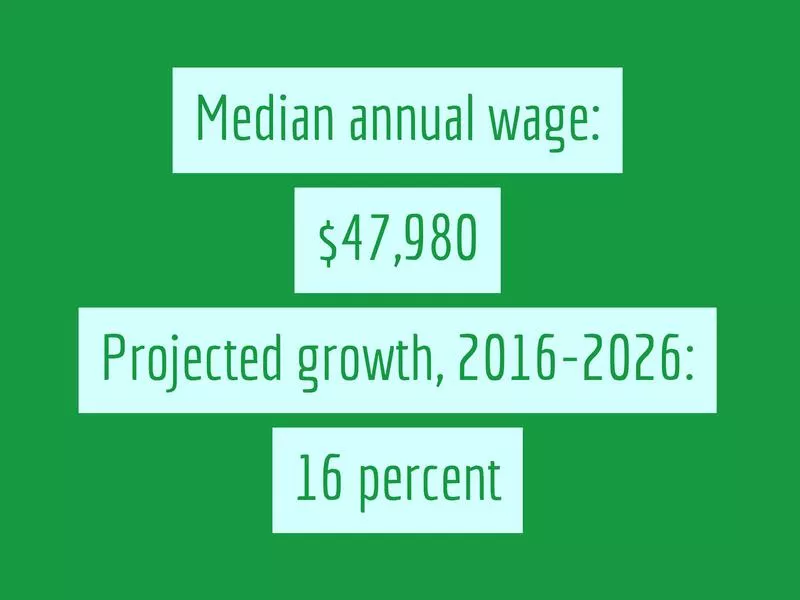
Mental health and substance abuse social workers help people solve and cope with problems, diagnose and treat mental, behavioral, and emotional issues.
The median annual wage for social workers was $47,980 in 2017.
They work in clinics, schools, child welfare and human service agencies, hospitals, settlement houses and private practices.
Some social workers need a bachelor’s degree in social work, but clinical social workers must have a master’s degree and two years of post-master’s experience in a supervised clinical setting. Clinical social workers must also be licensed in the state in which they practice.
Social work employment is projected to grow 16 percent from 2016 to 2026, driven by increased demand for healthcare and social services.
On the Rise: Massage Therapists
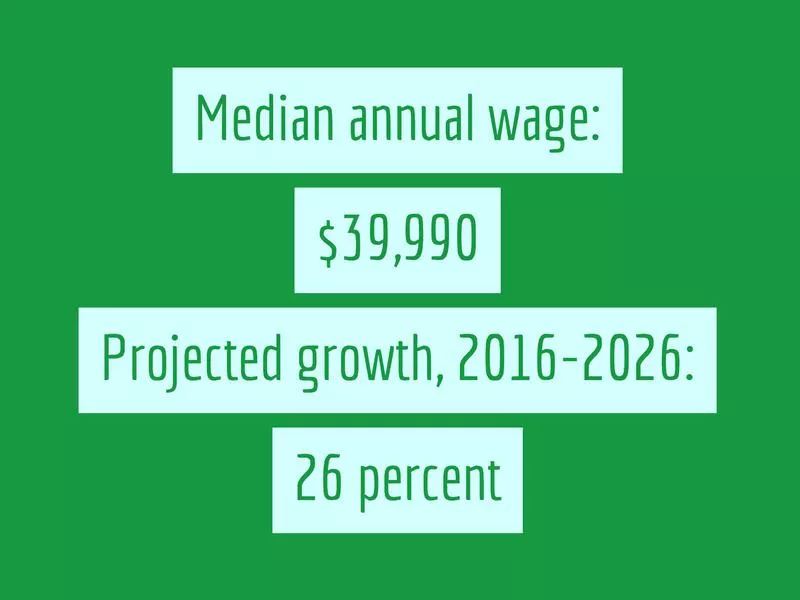
Massage therapists treat relieve pain, help heal injuries, improve circulation, relieve stress, increase relaxation, and aid in the general wellness of clients.
The median annual wage for massage therapists was $39,990 in 2017.
Massage therapists typically complete a postsecondary education program of 500 or more hours of study and experience, although standards and requirements vary. Most states regulate massage therapy and require massage therapists to have a license or certification.
Employment of massage therapists is projected to grow 26 percent from 2016 to 2026.
On the Rise: Market Research Analysts
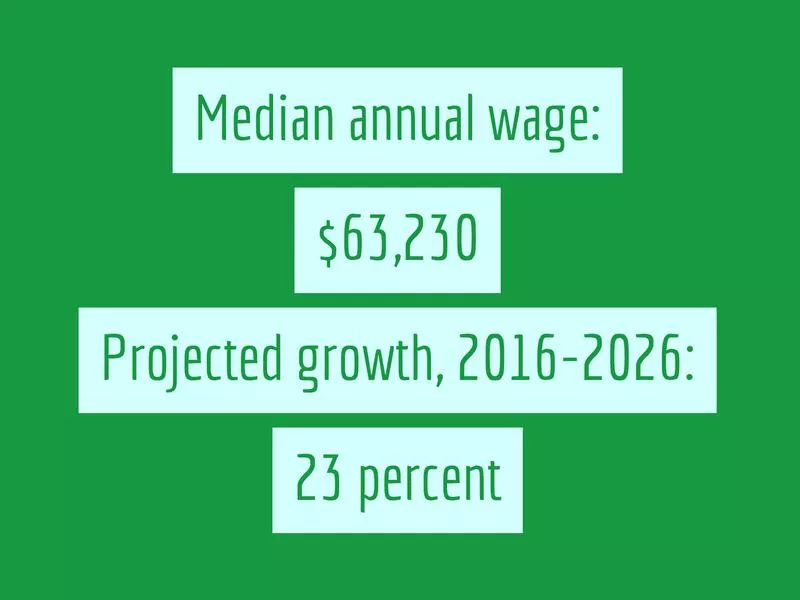
Market research analysts study market conditions to help companies understand what products people want, who will buy them, and at what price.
The median annual wage for market research analysts was $63,230 in 2017.
Because most industries use market research, these analysts are employed throughout the economy. Most need at least a bachelor’s degree, and some positions may require a master’s degree. Strong math and analytical skills are essential.
Employment of market research analysts is projected to grow 23 percent from 2016 to 2026, driven by an increased use of data and market research across all industries.
On the Rise: Interpreters and Translators
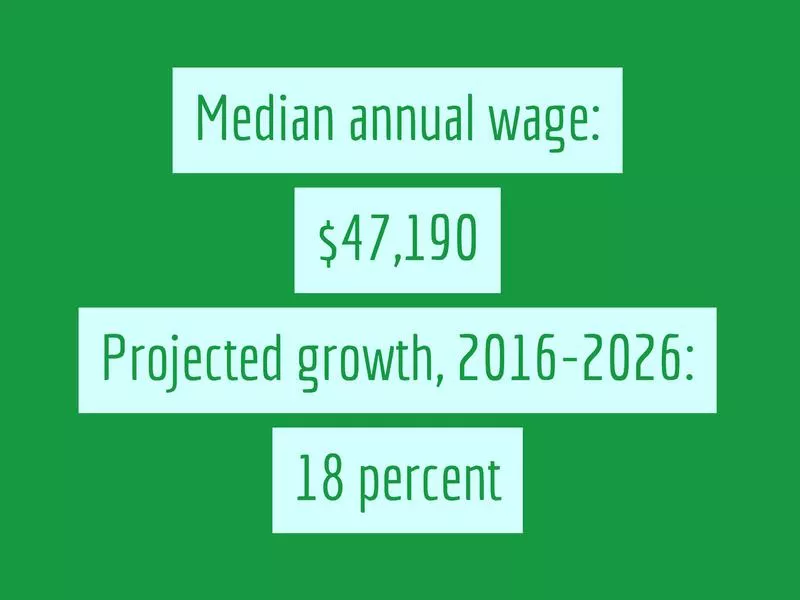
Interpreters and translators convert information from one language into another. Interpreters work in spoken or sign language, while translators work in written language.
The median annual wage for interpreters and translators was $47,190 in 2017.
Interpreters work in schools, hospitals, courtrooms, meeting rooms, and conference centers. Some work for translation and interpretation companies, individual organizations, or private clients. Translators also work remotely.
Although interpreters and translators typically need at least a bachelor’s degree, the most important requirement is to have native-level proficiency in English and at least one other language.
Employment of interpreters and translators is projected to grow 18 percent from 2016 to 2026, due to globalization and increases in non-English-speaking people in the United States.
On the Rise: Information Security Analysts
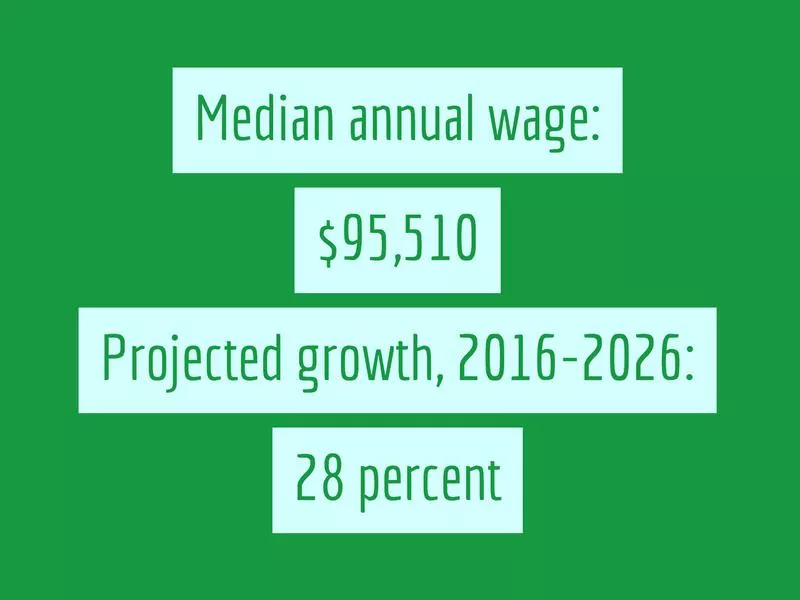
Information security analysts assess security measures to protect an organization’s computer networks and systems. Their responsibilities are continually expanding as the number of cyberattacks increases.
The median annual wage for information security analysts was $95,510 in 2017.
Most information security analyst positions require a bachelor’s degree in a computer-related field. Employers usually prefer to hire analysts with experience in a related occupation.
Employment of information security analysts is projected to grow 28 percent from 2016 to 2026. Demand is rising, as solutions are increasingly needed to prevent hackers stealing critical information or causing problems for computer networks.
On the Rise: Fundraisers
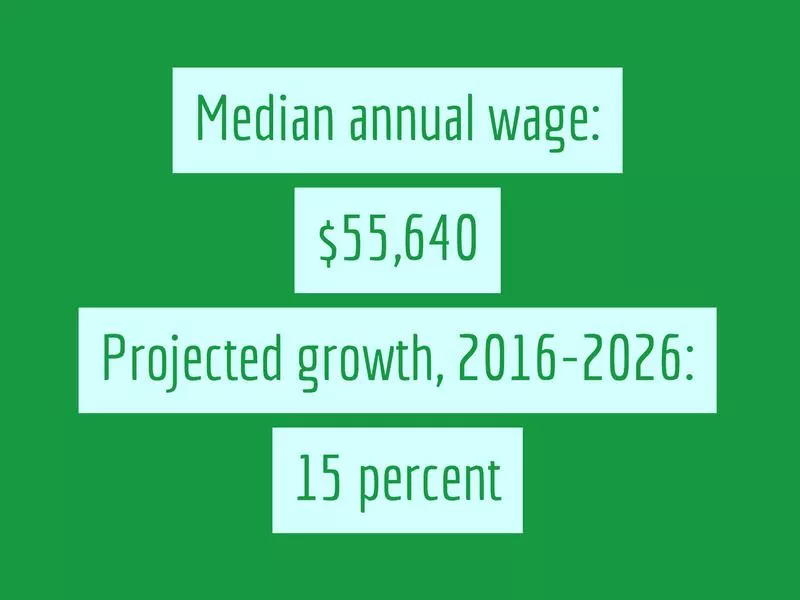
Fundraisers organize events and campaigns to raise money and other donations for an organization, design promotional materials and increase awareness of an organization’s work, goals, and financial needs.
The median annual wage for fundraisers was $55,640 in 2017.
Most work for nonprofit organizations, including educational institutions, religious organizations, health research foundations, social services organizations, and political campaigns.
Fundraisers typically need a bachelor’s degree and strong communication and organizational skills.
Employment of fundraisers is projected to grow 15 percent from 2016 to 2026, driven by the continued need of various types of organizations to raise money.
On the Rise: Financial Managers
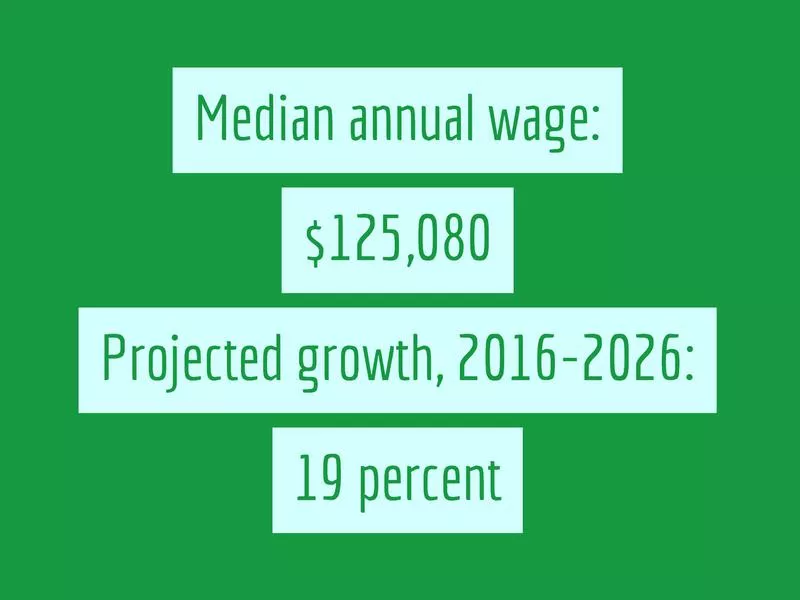
Financial managers are responsible for the financial health of an organization. They produce financial reports, direct investment activities, and develop strategies and plans for the long-term financial goals of their organization.
The median annual wage for financial managers was $125,080 in 2017.
Financial managers work in many industries, including banks and insurance companies. They typically have a bachelor’s degree and five years or more of experience in another business or financial occupation.
Employment of financial managers is projected to grow 19 percent from 2016 to 2026, Risk management and cash management are expected to be in high demand over the next decade.
On the Rise: Chefs and Head Cooks
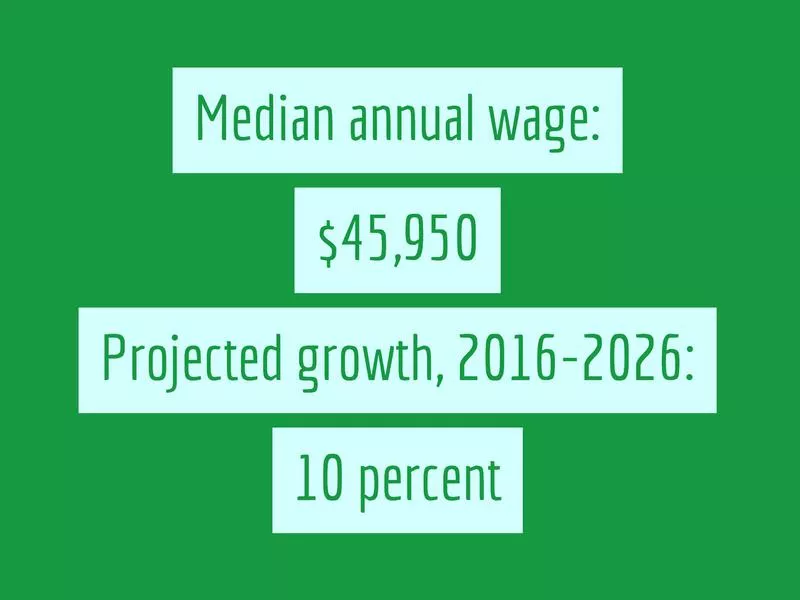
Chefs and head cooks oversee the daily food preparation at restaurants and other places where food is served. They direct kitchen staff and handle any food-related concerns.
The median annual wage for chefs and head cooks was $45,950 in 2017.
Chefs and head cooks work in restaurants, private households, and other establishments where food is served. They often work early mornings, late evenings, weekends, and holidays. The work can be hectic and fast-paced.
Most chefs and head cooks learn their skills through work experience. Others receive training at a community college, technical school, culinary arts school, or 4-year college. Some learn through apprenticeship programs.
Employment of chefs and head cooks is projected to grow 10 percent from 2016 to 2026. Most job opportunities are expected to be in food services, including restaurants, to replace workers who leave the occupation.
On the Rise: Dentists
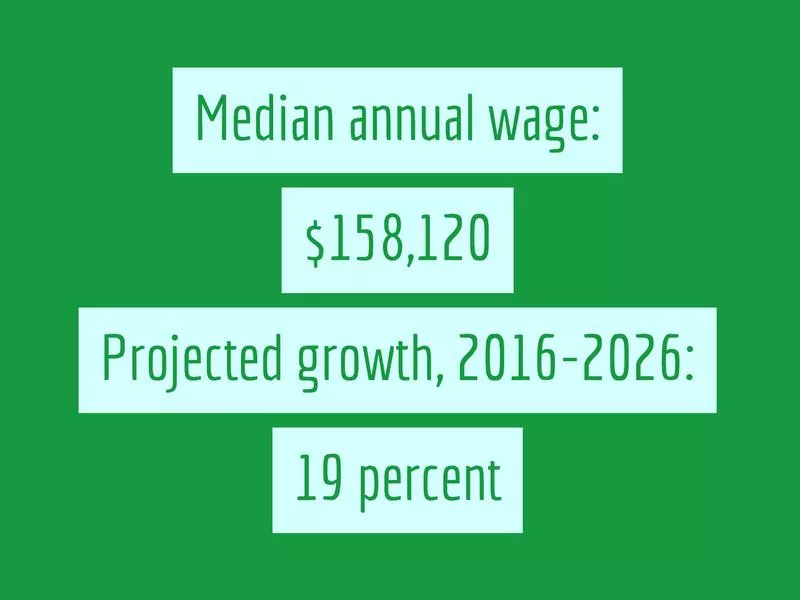
Dentists diagnose and treat problems with patients’ teeth, gums, and related parts of the mouth. They provide advice and instruction on taking care of the teeth and gums and on diet choices that affect oral health.
The median annual wage for dentists was $158,120 in 2017.
Dentists must be licensed in the state(s) in which they work. Candidates usually must graduate from an accredited dental school and pass exams.
Overall employment of dentists is projected to grow 19 percent from 2016 to 2026, as the population ages and as research continues to link oral health to overall health.